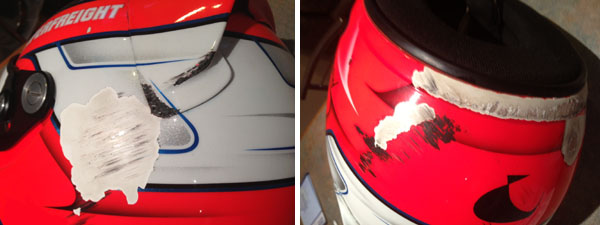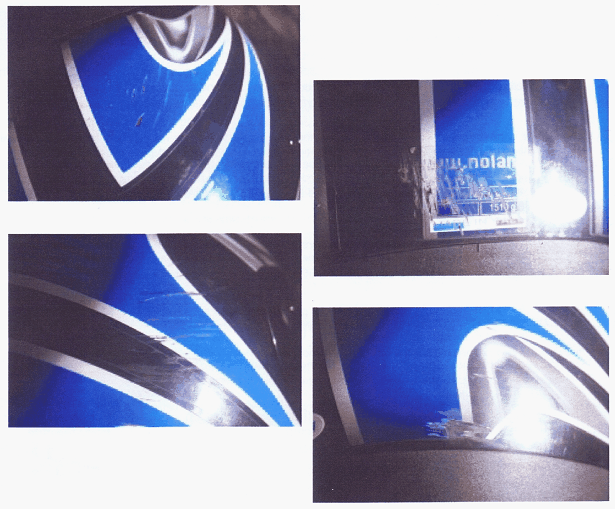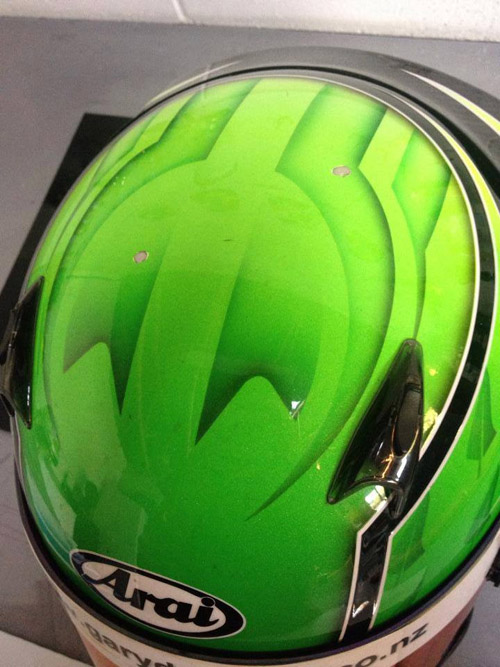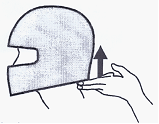G2 RACING HELMET & STANDARDS
| G2.1 | RACING HELMET: Racing helmet will only be a full face helmet with a properly fitted visor snapped shut and must be worn at all times when operating a kart. The helmet must be properly fitted and securely fastened. Helmets which can have any structural part detached or lifted (other than the visor) are not permitted. Helmets with built in rear view capability are not permitted. Only approved helmets are permitted and these must be maintained in A1 order. |
| An approved helmet must bear one of the listed approved standards. |
| For each calendar year racing helmets which comply with the standards as laid out below and which are in good condition and are less than 10 years old (as defined in G2.5), will receive a tamper proof year dated KartSport New Zealand sticker. |
| This sticker will be placed on the outside back of the helmet by a KartSport New Zealand Race Official. If the racing helmet is involved in an incident and sustains damage, which in the opinion of a Race Official makes it non compliant, or its condition deteriorates during the calendar year of the sticker, a KartSport New Zealand Race Official will remove the sticker. |
Competitors must wear a helmet at all times when within the racing confines including while waiting for a race, time trial or practice to be concluded and while riding on a recovery vehicle/trailer. The only exceptions are when the helmet needs to be removed under the supervision of medical personal or the competitor is standing in a designated safe area, eg Flag Point.
When the sticker is applied to the helmet it indicates that the inspector is happy with the condition of the helmet, that it complies with the Helmet Standards and is not older than 10 years. Once the sticker is applied it is valid for the calendar year. If during the course of that calendar year the helmet becomes more than ten years old, it can continue to be used only until the end of the calendar year for which the sticker applies. However it should be noted in the competitors log book and the competitor should be encouraged to replace the helmet at the 10 year age point.
It is important to remind competitors that if they pull out of a race, time trial or practice they must keep their helmets on until they are in a designated safety zone. |
|
| G2.2 | MINIMUM RACING HELMET STANDARDS APPROVED FOR KARTING COMPETITION IN NEW ZEALAND. – Refer to the current KartSport New Zealand Manual for all details. |
| G2.3 | HELMETS PERMITTED FOR INTERNATIONAL KARTING COMPETITION - Refer to the current KartSport New Zealand Manual for all details. |
All Race Officials must familiarise themselves with these standards and be able to recognise the various standard labels, a sample of which is shown below….





Checking a Helmet
Firstly look at the outer shell. Check for gouges that have gone into the gel coat and for star shape cracks. If it has either of these do not pass it. Some helmets have plastic clip-ons and vents. If they are broken or do not work don’t worry about it. They are cosmetic and have nothing to do with the structural make up of the helmet. However, it is important to check for fittings which are foreign to the helmet.
Check the visor and fittings. If the visor is badly scratched or the fittings are in disrepair which will not allow the visor to function correctly or 100mph tape is put on the fitting to either keep it closed or hold the fitting in place do not pass it.
Now to the straps. Follow the strap back to where it is fitted to the helmet. If there is rust around the rivet do not pass the helmet. If there is fraying of the strap from where the buckle would be when the helmet is worn decline the helmet. Fraying below the buckle is not a problem. If the helmet has the push together clips check that they stay clipped together.
Check the inside of the helmet to ensure all the padding is in place and not been damaged or removed.
Checking Helmet Date of Manufacture
ARAI HELMETS
Arai changed from having their date of manufacture on the chin strap to having a date code. The code is a letter followed by two numbers which identifies the year and month of manufacture.
For example G08 would mean date of manufacture is August 2007.
G (7th letter of the alphabet) = 2007
08 (8th month of the year) = August
The chart below is to make code identification easier.
Year of Manufacture |
Code |
Month of Manufacture |
Code |
2006 |
F |
January |
01 |
2007 |
G |
February |
02 |
2008 |
H |
March |
03 |
2009 |
I |
April |
04 |
2010 |
J |
May |
05 |
2011 |
K |
June |
06 |
2012 |
L |
July |
07 |
2013 |
M |
August |
08 |
2014 |
N |
September |
09 |
|
October |
10 |
|
|
November |
11 |
|
|
December |
12 |
Information on other manufacturer dates.
Some of the helmets coming into the country have an ECE label with the leading 05 on the ECE label but they have elsewhere a label with date of manufacture.
This date is back to front in some cases;
17 November 2004 we would write 171104.
In some helmets this is reversed 041117. Do not confuse the leading 04 as part of the ECE standard.
Checking the Certification
All helmets MUST have a date of manufacture. Rule G2.2 says where you are most likely to find the certification sticker or label. The date of manufacture can be harder to find. If either you can’t find the date or the owner cannot supply the information, Rule G2.5 applies.
Info to help the owner....
Some helmets do not have a date of manufacture inside them, but sometimes the ticket with helmet when purchased will have this information. Most helmets will have a small label with a series of numbers which mean nothing to us but will mean something to the manufacturer. Advise the owner can go back to the retailer and request the information from the manufacture.
A Date of Manufacture MUST be able to be viewed on or in the Helmet
Reason:
Australia: AS 1698
Australia has had the same certification number for many years. They make amendments to the testing standards on a regular basis. The Australian test follows very closely to Snell procedures.
Britain BSI 6658-85 Type A or BSI 6658-85 A/FR
Britain like Australia continue with the same certification but make regular amendments to the testing standards.
USA: SFI 31.1A & SFI 31.2A
Same as above.
USA: Snell K98, M2000, SA2000, M2005 & K2005
Note: K=Kart, M=Motorcycle, SA=Car. The numbers after the letter/s is the year that particular certification started. ie a K98 certification was introduced in 1998. This means that there may be some helmets in use that are more than 10 years old. The same goes for M2000 and SA2000, some of these helmets could be past their use by date.
Europe: ECE 22-05
The 05 numbers are just a part of identifying the certification process. The 05 certification was introduced in 2000 which means some of these helmets could be past their use by date.
Be wary of helmets which have been purchased from overseas especially with Snell Stickers in them. In 2004 the Snell Foundation sent one of their members to New Zealand to check helmets with Snell stickers at many retail outlets. There obviously is a concern that certification labels are being copied.
| G2.4 | It is the competitor’s responsibility to prove the quality of the helmet. It is not necessary for a Machine Examiner or the Chief Steward to prove the standard or quality of an unidentified helmet. |
| G2.5 | Age will be determined by the manufacturer’s date of manufacture labelling. Where no date of manufacture is visible on the helmet the onus is on the competitor to prove the helmet is less than 10 years old. Date of purchase is not evidence of the age of the helmet. No KartSport New Zealand tamper proof year dated sticker will be applied for a calendar year to any helmet which is more than 10 years old. |
| G2.6 | The Chief Steward is empowered to impound any helmet considered of insufficient standard or, if of approved design, in a damaged or unsound condition. |
G2.7 Only helmets with a strap retaining system are permitted.
G2.8 Helmets are not to be modified, except as specifically permitted by the helmet manufacturer, in particular;
(a) ABS and Polycarbonate helmets must not be painted.
(b) It is not permisable to put any stickers on ABS or Polycarbonate helmets other than those supplied by the helmet manufacturer.
(c) Composite shell helmets may only be painted with a paint approved by the manufacturer.
Procedure: Request competitor to put helmet on and strap it up. Put upwards pressure on the back of the helmet and ask the wearer to resist your upwards push. |
|
The issue of poorly fitting helmets is not with the Senior or older Juniors but with the Cadet and Junior Restricted age groups.
The FIA and Snell have developed a child’s helmet and these are recommended for this age group. The certification is Snell CMS2007 & CMR2007 and these are now compulsory for children under 15 years of age in International karting competition.
G2.10 The use of helmet restraints securing a competitor’s helmet to the kart are not permitted.
| G2.11 | HELMET VISORS: These must be properly fitted to give complete eye protection at all times. Visors must be correctly fitted. Any foreign attachment to the visor to hold it in place is not acceptable. Visors which change colours (ie Blue Blockers) are not acceptable. Only clear visors can be used when competing at events under lights. When using a wet weather whirly a properly fitted visor must be used as well. All visors must be clean and free of scratches and marks. Any attachment to the visor must not be lower than eye level when worn. |
The Chief Steward is empowered to impound any helmet visor considered of insufficient standard or clarity, damaged or unsound condition.
Protective film or tear offs are permitted on visors but must not be removed or discarded whilst the competitor is within Sprint Circuit racing confines.
| G2.12 | CAMERA: It is not permitted to attach a camera to a helmet except as specifically permitted by the helmet manufacturer. Such helmet camera must be wireless. (ie not connected to the kart and/or recording device via cable). Helmet, with camera mounted, must be inspected and approved by the Chief Steward before use. |
Except for a helmet camera as noted above, the carrying of a camera or associated equipment on a driver’s person is prohibited.
| G2.13 | NECK BRACES: The wearing of neck braces for drivers of situp karts is strongly recommended. |
| G2.14 | KARTING BODY PROTECTION: The wearing of a karting body protection device (rib protector) is mandatory at all times, for practice, demonstration or competition. This rule applies to all classes except the Superkart International class. A CIK-FIA Standard device is strongly recommended. |
This Red helmet below has been in a major accident and is no longer fit for purpose.
This type of damage is very obvious.
Clearly the helmet has done its job.

The Blue helmet below has also been in a major incident and while the damage my not look as dramatic the helmet is no longer fit for purpose.

The Green helmet below has some stone chips and is still fit for purpose and able to be used.


